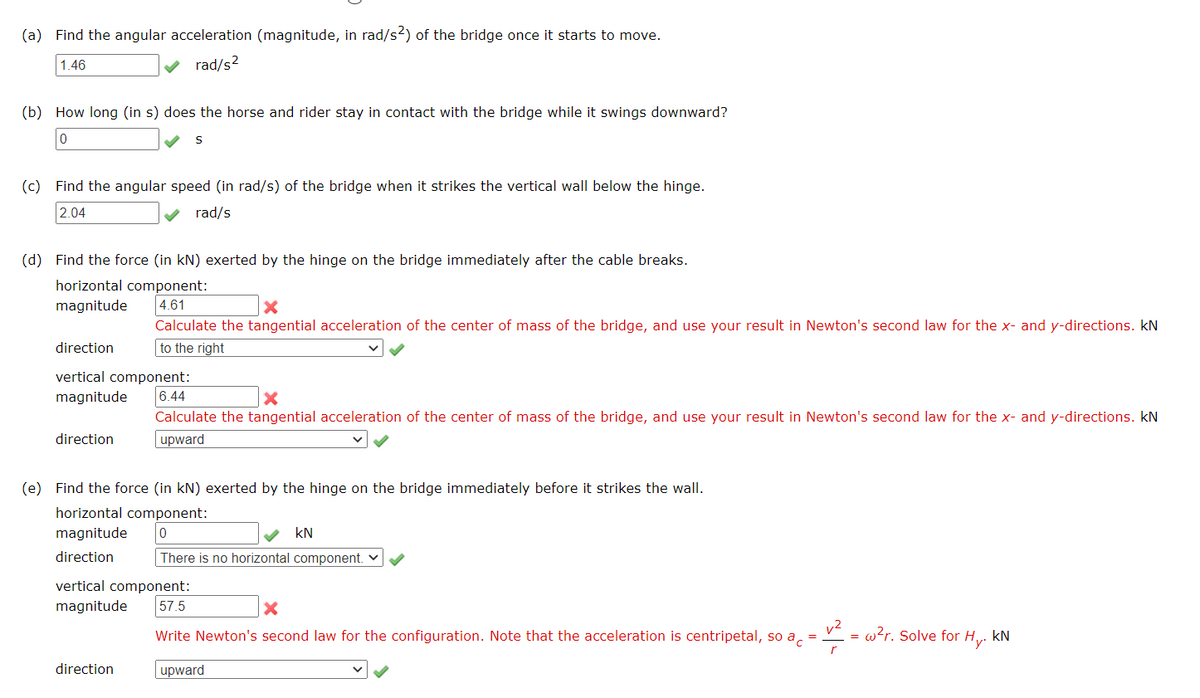A person on horseback is on a drawbridge which is at an angle e = 20.0° above the horizontal, as shown in the figure. The center of mass of the person-horse system is d = 1.30 m from the end of the bridge. The bridge is e = 9.50 m long and has a mass of 2,350 kg. A cable is attached to the bridge 5.00 m from the frictionless hinge and to a point on the wall h = 12.0 m above the bridge. The mass of person plus horse is 1,100 kg. Assume the bridge is uniform. Suddenly (and most unfortunately for the horse and rider), the ledge where the bridge usually rests breaks off, and at the same moment the cable snaps and the bridge swings down until it hits the wall.
A person on horseback is on a drawbridge which is at an angle e = 20.0° above the horizontal, as shown in the figure. The center of mass of the person-horse system is d = 1.30 m from the end of the bridge. The bridge is e = 9.50 m long and has a mass of 2,350 kg. A cable is attached to the bridge 5.00 m from the frictionless hinge and to a point on the wall h = 12.0 m above the bridge. The mass of person plus horse is 1,100 kg. Assume the bridge is uniform. Suddenly (and most unfortunately for the horse and rider), the ledge where the bridge usually rests breaks off, and at the same moment the cable snaps and the bridge swings down until it hits the wall.
Mechanics of Materials (MindTap Course List)
9th Edition
ISBN:9781337093347
Author:Barry J. Goodno, James M. Gere
Publisher:Barry J. Goodno, James M. Gere
Chapter5: Stresses In Beams (basic Topics)
Section: Chapter Questions
Problem 5.12.11P: A cylindrical brick chimney of height H weighs w = 825 lb/ft of height (see figure). The inner and...
Related questions
Question
100%
part d and e please

Transcribed Image Text:A person on horseback is on a drawbridge which is at an angle 0 = 20.0° above the horizontal, as shown in the figure. The center of mass of the person-horse system is d = 1.30 m from the end of the bridge. The
bridge is e = 9.50 m long and has a mass of 2,350 kg. A cable is attached to the bridge 5.00 m from the frictionless hinge and to a point on the wall h = 12.0 m above the bridge. The mass of person plus horse is
1,100 kg. Assume the bridge is uniform. Suddenly (and most unfortunately for the horse and rider), the ledge where the bridge usually rests breaks off, and at the same moment the cable snaps and the bridge
swings down until it hits the wall.
HTHI ATLA TAHI A AUTA A TH

Transcribed Image Text:(a) Find the angular acceleration (magnitude, in rad/s2) of the bridge once it starts to move.
1.46
rad/s?
(b) How long (in s) does the horse and rider stay in contact with the bridge while it swings downward?
(c) Find the angular speed (in rad/s) of the bridge when it strikes the vertical wall below the hinge.
2.04
rad/s
(d) Find the force (in kN) exerted by the hinge on the bridge immediately after the cable breaks.
horizontal component:
magnitude
4.61
Calculate the tangential acceleration of the center of mass of the bridge, and use your result in Newton's second law for the x- and y-directions. kN
direction
to the right
vertical component:
magnitude
6.44
Calculate the tangential acceleration of the center of mass of the bridge, and use your result in Newton's second law for the x- and y-directions. kN
direction
upward
(e) Find the force (in kN) exerted by the hinge on the bridge immediately before it strikes the wall.
horizontal component:
magnitude
kN
direction
There is no horizontal component. v
vertical component:
57.5
magnitude
Write Newton's second law for the configuration. Note that the acceleration is centripetal, so a, =
w?r. Solve for Hy.
kN
direction
upward
Expert Solution
This question has been solved!
Explore an expertly crafted, step-by-step solution for a thorough understanding of key concepts.
This is a popular solution!
Trending now
This is a popular solution!
Step by step
Solved in 3 steps

Knowledge Booster
Learn more about
Need a deep-dive on the concept behind this application? Look no further. Learn more about this topic, mechanical-engineering and related others by exploring similar questions and additional content below.Recommended textbooks for you

Mechanics of Materials (MindTap Course List)
Mechanical Engineering
ISBN:
9781337093347
Author:
Barry J. Goodno, James M. Gere
Publisher:
Cengage Learning

Mechanics of Materials (MindTap Course List)
Mechanical Engineering
ISBN:
9781337093347
Author:
Barry J. Goodno, James M. Gere
Publisher:
Cengage Learning